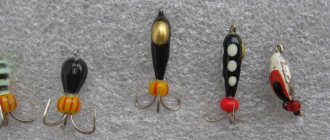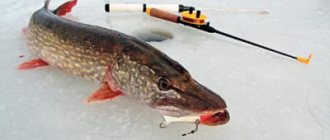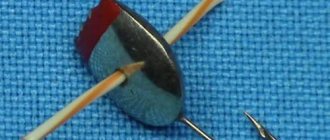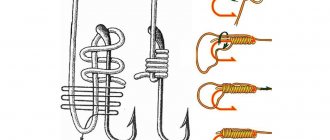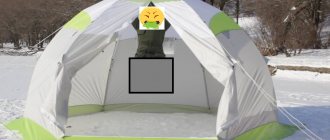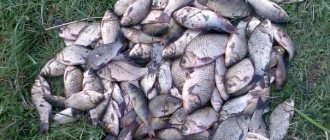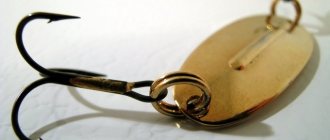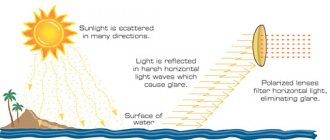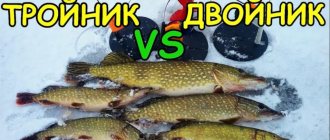Winter fishing is a great pastime. Despite the frost, the fish you catch will always give you a lot of pleasure. In order not to sit at an “empty” hole, we recommend that you read this article, because fishing in winter is much more difficult than in summer. This applies primarily to the equipment of a winter fishing rod, which must be selected separately for different types of fish, as well as for fishing locations.
Features of winter fishing
Winter fishing has many features. Its most important difference from the summer one is the behavior of the fish, which in winter becomes less active and extremely cautious. This is especially true for non-predatory species, which are mainly hunted in winter. In order for the fish to bite better, thin and inconspicuous gear is selected for the fishing rod.
Another unpleasant feature is the cold. Choose gear that makes it convenient for you to work with it, for example, to set bait, because your hands, wet from fish, will quickly freeze.
Float or nod fishing rod
A fishing rod with a float is a must-have tool for many bream fishermen. Floating a winter fishing rod for roach and other types of fish is also a good idea, but there is a nod to it.
The choice between these two options depends entirely on your preferences, however, professional fish often use a float rod, because it is the key to successful winter fishing.
Among the advantages of nodding gear, one can highlight convenience: it is much more convenient to search for a school of fish, however, having found a “gold mine”, many fishermen return to the float again.
Fishing rods for float winter fishing
When preparing for winter fishing, you first need to choose a suitable fishing rod. There are many types, but they do not affect the result, so again, rely on your own preferences. The only thing you need to pay attention to is the rod of the fishing rod. It should be flexible enough so that when a fish bites you can easily hook the fish and weaken it.
All fishing rods for winter fishing are divided into two types:
- Sports ones, in which the handle and reel are combined to make the design as light as possible. Such fishing rods have plastic legs, which are also lightweight, so even in a slight wind they may not be able to hold the rod.
- The amateur version is made as comfortable as possible, for example, they fit better in the hand, and the legs can withstand gusts of wind and make it easy to pick up a fishing rod when biting. Another difference from the sports version is the greater weight, but this is not so important when fishing “for yourself.”
We recommend focusing on the amateur version, which can be represented by various “fillies”, “tripods”, etc. Among them, the simplest, cheapest, but reliable option is the “filly”, the difference of which lies in the reel – a plastic device for manually winding fishing line. Some people find this inconvenient, so they use fishing rods with a reel or a balalaika.
TOP 7 - best fishing rods
Salmo PRO TROUT cost: 1557 rubles.
The main feature of the model is the whip, made of 2 materials: carbon fiber and carbon fiber. The rod itself is very flexible. Thanks to this fact, the game with bait becomes better, which means the catch will be greater. The model itself is very light for its size, but no less durable. This model weighs 36 grams and is 60 centimeters long. The handle is made of cork which also reduces weight.
Main advantages:
Good durability Light weight High quality materials Very comfortable.
User reviews:
Rapala 90/GL230/2-С. cost: 550 rubles.
This rod can be considered the golden mean. Low cost and good technical performance. Its dimensions are 52 by 37, where 52 is the weight in grams, and 37 is the length in centimeters. The handle is made of rubber and does not slip out of your hands, and there is also a nod that warns of a bite.
Main advantages:
Low cost. Little weight. Pleasant to use. High quality material is used.
User reviews:
Victor (Sakhalin region)
PIRS 50 PL cost: 50 rubles
A simple and convenient fishing rod at a low price, made in Russia. It is 39 centimeters long, and is made of ordinary inexpensive plastic, which, in principle, holds up well in the cold. There is a built-in reel.
Main advantages:
Low cost Low weight. Well thought out look.
User reviews:
Profi UP-1 price 65 rubles.
A good rod at a low price. This model is very light and easy to use, made of plastic that withstands frost and shock well. There are no deformations after strong bending.
Main advantages:
The design has folding legs. Removable six, assembled from carbonate. Special fastenings for six.
User reviews:
Condor Ice 402H price 270 rubles
This rod is lightweight, conveniently designed and very easy to use. The weight of this model is 67 grams and the length is 40 centimeters. There is a reel with a special section for storing fishing line. Using this gear you can fish with a float, jig and spinner.
User reviews:
Sudak 50N price 180 rubles
The material used is frost-resistant plastic. More often they go for pike perch with such a fishing rod. The model itself is rigid, which gives it an advantage in hooking fish. In addition to pike perch, it is used for vertical fishing. The handle is made of cork and is therefore very light. Length 50 centimeters.
User reviews:
Suomi 50 price 340 rubles.
Good Finnish quality and versatility. This model is equipped with a rigid whip, the material of which is polycarbonate with a high level of resistance to cold. A comfortable handle made of cork, and the length of the product is 35 centimeters. There is a button for quickly switching the stopper from a working state to a non-working state.
User reviews:
Kirill (Altai region)
Among the models of winter fishing rods used for jig fishing, the following “balalaikas” are especially popular among anglers:
Material
Modern jigs are made from materials such as:
- plastic;
- lead;
- tin and its alloys;
- tungsten.
Heavy jigs made of tungsten and lead are used when fishing at great depths, light baits made of tin and plastic alloys are used for shallow water.
Form
The shapes of jigs are:
- spherical - “pellet”;
- teardrop-shaped - “drop”;
- calpe-shaped curved shape - “uralka”;
- flattened - “perch eye”;
- in the form of an ant - “ant”;
- in the form of a grain - “ovinka”;
- in the shape of a ball cut in half - “bug” “cobra”;
- cone-shaped - small “balda”;
- rod-shaped - “cloves”.
Tips for fisherman: Do-it-yourself winter fishing rod for trolling - Detailed review
By color these baits are:
- dark;
- silver;
- golden;
- fluorescent.
Dark-colored jigs are used for fishing in clear water with fairly good lighting and shallow depth. Lures of silver and golden color are used at medium and deep depths in conditions of lack of light under the ice.
Fluorescent jigs, thanks to their coating that glows even with a small amount of light, are used for fishing at great depths in morning or evening twilight conditions.
- Select Perch 50cm 36g;
- Select Zander 50cm 48g;
- Karismax Maxtreme 4 39 div EVA;
- Lucky John C-Tech Jigging 40 cm.
The automation process has reached winter equipment, which has significantly expanded the capabilities, and now you can purchase a product with electronics. It is very convenient for performing various movements - playing with a spoon, hooking and playing fish.
Important! To catch a large predator, it is necessary to have a more elongated type, which has increased elasticity and reliability.
When pulling out large fish, cases of the fishing rod flying out onto the ice often occur; If dropped, only the high-quality material of the fishing rod body is resistant to breakage. Since you often have to fish with your bare hands, it is advisable that the handle be made of “warm” material.
Adams offers good options :
- IFR-2000Н;
- IFR-3000L;
- IFR-1000.
And also the following models:
- Select Perch 50cm 36g;
- Select Zander 50cm 48g;
- Karismax Maxtreme 4 39 div EVA;
- Lucky John C-Tech Jigging 40 cm.
In order not to make a bad choice, there is a rating of the most convenient and popular fishing rods for winter fishing:
As for the Rapala 90/GL230/2-C whip, it is an elastic composite tube that reacts to any slightest touch of the fishing line. For experienced anglers, this nodding behavior does not pose a particular problem, but fishing beginners often mistake deviations for a full bite, which is why they unwittingly reduce fishing efficiency. However, whip control can be easily learned - just spend a few hours with this fishing rod.
| Nomination | place | Name of product | price |
| Rating of the best winter fishing rods | 1 | Salmo PRO TROUT (60 cm) | 1 646 ₽ |
| 2 | Rapala 90/GL230/2-С | 716 ₽ | |
| 3 | Lucky John C-Tech Perch (43cm) | 1 514 ₽ | |
| 4 | Teho Bumerang Special | 1 090 ₽ | |
| 5 | Salmo Travel (60cm) | 1 405 ₽ | |
| 6 | Stinger ProFire 65M | 525 ₽ | |
| 7 | DELFIN VR70E | 460 ₽ |
Salmo PRO TROUT (60 cm)
It would seem that such a weight characteristic does not contribute to high strength, but the words of users say otherwise. In particular, some of them managed to catch pike weighing up to 3 kilograms, without visible damage or bending of the whip. In general, from the point of view of operation, the Trout has proven itself exceptionally well, for which it was awarded a high position in the top of the best winter fishing rods.
Advantages
- The optimum ratio of price and quality;
- lowest weight with standard dimensions (35 grams);
- extended set (case and plastic tube);
- the presence of tight rings for fixing the reel (on the handle).
Flaws
- not detected.
Rapala 90/GL230/2-С
As for the Rapala 90/GL230/2-C whip, it is an elastic composite tube that reacts to any slightest touch of the fishing line. For experienced anglers, this nodding behavior does not pose a particular problem, but fishing beginners often mistake deviations for a full bite, which is why they unwittingly reduce fishing efficiency. However, whip control can be easily learned - just spend a few hours with this fishing rod.
Advantages
- low cost;
- high fishing efficiency;
- ease of use due to the use of simple mechanisms and elements;
- Moderately durable construction.
Flaws
- frequent misfires due to the high sensitivity of the whip.
Lucky John C-Tech Perch (43cm)
In terms of reliability, the Lucky John C-Tech Perch winter fishing rod occupies, perhaps, the highest places among its peers, which naturally compensates for the level of cost. Sensitive and lightweight, it allows you to fish with balance beams and vertical spoons, dragging (sometimes) even very large fish from under the ice. Mainly due to the solid type tip, which can withstand high loads at the time of fishing and when performing hooking.
The Lucky John C-Tech Perch rod handle also has interesting features. Completely made of cork, it has two locking graphite rings on itself, designed to secure the reel. This design makes it possible to install the body kit in any convenient place, but has a vulnerability in the form of a loose fit and the possibility of the ring moving out of its place. However, this is the only constructive nuance that remains unthought through - everything else has no complaints.
Advantages
- high degree of reliability of structural elements;
- comfortable cork handle;
- Possibility of fishing with balance beams and spoons;
- floating reel mounts.
Flaws
- the stopper may move out of its place on the handle (loosening the reel fastening).
Teho Bumerang Special
As winter fishing enthusiasts note, Teho Bumerang Special gives a special fishing experience. The dynamics of the fishing rod are so different from standard models that even experienced anglers have to adapt to new conditions. Engineering creativity worthy of a place in the ranking of the best.
Advantages
- unusual design (all plastic body);
- high resistance to bending loads;
- elasticity and immunity to plastic deformation of the base material;
- presence of an undercutting device.
Flaws
Salmo Travel (60cm)
Despite such risky games with the design, the fishing rod received excellent endurance indicators. Judging by the reviews, experienced fishermen have more than once managed to catch a fairly large predator (pike) with it in situations where a cliff seemed inevitable.
Advantages
- original performance;
- integration of the reel directly into the handle area (to reduce the size of the rod);
- moderately durable telescopic design;
- presence of a cover included;
- small transport size (29.5 centimeters).
Flaws
- not detected.
Stinger ProFire 65M
According to consumers, this winter fishing rod is classified as the best of the cheap. It makes no sense to equip it with a good kit (reel, fishing line) - the blank and whip, with a heavy hook, will not be able to resist dynamic loads and will most likely break off. However, even with a modest set it is able to show high fishing efficiency, which is its main advantage over others.
Advantages
- optimal ratio of overall parameters;
- low price in the segment;
- possibility of flashing;
- Solid neoprene handle, separated by space for the reel.
Line for winter float fishing rod
Buying fishing line is an important step in equipping a winter float fishing rod. Using a float, you need to take a fishing line of about 0.1 mm. It will be inconvenient to work with, but with practice you will achieve the necessary skills.
When going fishing for large fish, do not rush to take a thick fishing line, because in winter the fish are quieter, which allows you to catch them with a thin fishing line. To avoid tearing it during the bite, remain calm and take your time. It’s better to wear out the fish for a long time than to break the line and miss the catch.
Let's talk about fishing line sizes in more detail. If you want to catch fish up to 1.5 kilograms, then choose a fishing line with a thickness of 0.12-0.14 mm. When fishing at depths below 10 m, you can take a thicker line, for example, 0.16-0.18 mm. Also, do not forget about choosing the right length. It should be 10-15 m greater than the depth of the reservoir.
With a nod and a jig
As a bite alarm for ice fishing, many people prefer to use a nod instead of miniature floats. This is a convenient choice for fishing with a retrieve at different depths from a boat or from ice, in still water or in current conditions. It makes it possible to clearly record the bite signal with a variety of wiring techniques and playing with a jig. This method is used to catch white fish - ruff, pike, perch, bream, silver bream and roach. There are several types of fishing rods suitable for winter fishing.
Tips for a fisherman: How to tie a devil to a winter fishing rod - Answers for beginners
The most popular among fishermen are:
- “Filly” , whose design dispenses with moving elements. Previously, it was placed on legs next to the hole, which is why it got its name. Today it is used without legs. It doesn’t even have a reel: the fishing line is wound around a handle with special grooves. The low weight of the fishing rod increases sensitivity to bites, but the lack of a reel makes this model less comfortable to use.
“Classic” , i.e. a version of a classic rod suitable for jig fishing. It is a handle where the reel and whip are secured. This design requires a special stand in the form of legs for easy placement near the hole. This rod is easy to maintain and suitable for catching sleepy fish, but the increased weight may affect the ease of action of the bait.
Selection of equipment
If you are equipping a fishing rod for the first time, follow the advice of experienced fishermen and pay attention to every significant detail in the design of a winter tool:
Reel or reel. Necessary for adjusting the length of the fishing line to avoid tangles and breaks. When choosing a reel, pay attention to how well it rotates and locks securely, and whether it can prevent the line from spontaneously coming off. Its body must withstand impacts on ice, so make sure that the material is waterproof and frost-resistant. Be careful when using the spool: the closed type does not allow water, snow and ice to get inside and freeze.
Nozzle. It can be different - bloodworms, maggots, worms, bark beetle larvae are suitable, the presence of which should be taken care of in advance. Many people do without them - crucian carp or perch will be attracted even by a red woolen thread or the brightness of the color and shine of the bait. Baitless fishing involves high-precision adjustment of the sensitivity of the nod for uniform high-frequency play with the bait.
Installation
The sensitivity of properly selected gear with a nod and a jig allows you to react to any touch of the bait by a small fish. An unmistakably chosen nod creates an increased vibration frequency of the jig with or without an attachment, which provokes sedentary fish at this time of year to actively attack the tackle. Installing the equipment on a winter fishing rod is not difficult.
To do this, do the following:
Video: Installation of equipment for a winter fishing rod
Drill a hole and clear the surface of the water from small pieces of ice so that nothing interferes with the float.
Fishing with a winter float differs in many ways from fishing with a float rod in the summer.
Drill a hole and clear the surface of the water from small pieces of ice so that nothing interferes with the float.
The float must be loaded with at least two pellets; a small pellet should be placed 5-7 cm from the hook with the nozzle. This will allow the bait to sink slowly, which has a positive effect on the fish’s attention to the bait.
After catching a fish and placing a new bait on the hook, if the old one is missing, lower the tackle into the water again. The line may become slightly frozen with ice when immersing the line - pass it through the clenched fingers of your glove to remove the ice.
Leash. This is a small piece of fishing line that is designed to make the tackle around the hook and bait less noticeable. In addition, the leash serves to protect the line from breaking if there is strong resistance from the fish - it breaks, but the line with the float remains.
A float rod is the most popular fishing tackle that can be used to fish from the shore, from a boat, in shallows and in depth, in currents and in still water. And you can catch almost any fish that lives in our reservoirs. It can be used in all seasons, except when the water is covered with ice.
Let's start with the most important part - the fishing rod. The purpose is to deliver the bait to the right place, hook and pull out the catch. The fishing rod for a float rod should be long enough (from 2.4 m), flexible, durable and light. It's good if it has access rings, but this is not necessary. According to their design, fishing rods are divided into solid, composite - from 2,3 or more legs, which are connected by metal rods.
The color of the fishing line plays a very important role. For daytime fishing you need to take a transparent one, for the night – a dark one. In spring - green, and in autumn - brown. This makes it less noticeable in the water. Depending on the type of fish, the diameter of the fishing line is selected as follows:
- bleak, ruff, crucian carp, perch - 0.15-0.18 mm;
- large crucian carp, asp, bream, small pike perch and carp - 0.2-0.3 mm;
- pike perch, carp, carp – 0.35-0.4 mm;
- silver carp, catfish, other large fish – 0.5-1.0 mm.
Leash. This is a small piece of fishing line that is designed to make the tackle around the hook and bait less noticeable. In addition, the leash serves to protect the line from breaking if there is strong resistance from the fish - it breaks, but the line with the float remains.
Many people tend to use a very thin leash, but one must understand that it must be proportionate to the entire tackle. Select the length depending on the fishing method. It is advisable that the leash be at least the color of the water. For a standard float fishing rod, the most practical would be a leash 18-25 cm long and 0.1 mm thinner than the main line.
Methods for tying two pieces of fishing line
Sinker. The simplest thing is an ordinary lead pellet. You cannot take nuts or nails - they simply tear the tackle when casting. In addition to the round shot, “stalk” and “spindle” weights are also suitable for float fishing rods. But you shouldn’t take it in the form of a drop; they are used on spinning rods.
For catching fry with live bait - No. 1-3.
Small fish - crucian carp, bream, bleak - No. 4-6.
For medium-sized fish: carp, carp, bream, asp - No. 7-10.
For large fish - catfish, pike perch, barbel - No. 10-15.
Knot strength table
The float is the main bite indicator and holds the hook with the nozzle at the desired depth for the fisherman. There are several types of floats and each has its own function.
Floats for 2-3.5-meter rods intended for catching small fish at a short distance from the shore should be light and small. In this case, the fishing line is tightly attached to the rod.
To catch small fish in reservoirs with weak currents, in lakes: crucian carp, perch, roach, tench, bream, it is best to take thin and long floats with a thickened lower or upper part. The tackle can be either a blind rod or a fishing rod with a reel.
Tips for fisherman: How to catch pike perch in winter from ice - Features of choice
Floats for use in currents where there are constant whirlpools and currents. The optimal shape is a float in the form of a barrel, since it is difficult to lay it on its side or be blown around by the wind. Their large diameter and short length prevent such a float from sinking in whirlpools.
For long casts, you should take heavy sliding floats, which must be secured with a locking knot. These floats allow you to cast bait 20 meters or more from the shore.
But the heaviest barrel floats, very massive ones, should be taken for fishing with live bait. It has several functions - to hold the live bait in the right place, preventing it from moving to the side. But also not to frighten the predator - that is, the lower part should not be massive and very mobile even with sudden movements of the live bait.
A float rod is the first tackle of most anglers, and many, even with the coolest spinning rods, still find time to sit by the water, or even catch a real trophy specimen.
Did you like the article? Subscribe to the channel to stay up to date with the most interesting materials
The general scheme for attaching a float to a fishing rod looks like this:
Hooks for float rod
It is necessary to choose a hook with special attention, because the success of your fishing depends on its quality. First of all, it must be thin and elastic, have an elongated fore-end and a paddle for tying.
Choosing a hook number is more difficult, because everything here depends on the fish that are found in the reservoir. For example, when choosing the equipment of a winter float fishing rod for roach or bream, you should take hooks No. 18-20, and for larger specimens - No. 14-18.
Fishing with jigs is also allowed, but their effectiveness in winter fishing conditions is often questioned. Regardless, you can try them too. We recommend using a combination: attach the jig to the end of the leash, and hook the hook to the fishing line 20-30 cm higher.
Float for winter fishing rod
Choosing a float is much easier than the rest of the equipment for a winter fishing rod, however, there are some subtleties here too.
The float should be bright in color so that it can be easily followed through the water, because its working position is in it. In the store you can find a huge number of floats of various colors, but fishermen are not very fond of them.
Many people prefer to make it themselves, securing it to a fishing line in a special way:
- Place the braided telephone wire onto the fishing line.
- Attach the float.
- Thread its keel into the braid.
Why is it important to keep the float underwater? The fact is that the surface of the water in the hole can freeze at sub-zero temperatures, which significantly reduces the sensitivity of the float, which is extremely important in winter fishing. This is the only rule regarding the float, because its shape, color and fastening are a matter of taste.
Loading a winter fishing rod
When rigging a winter fishing rod, you need to hang at least two weights - the main one and the secondary one. Professional fishermen can use more weights, but it will be difficult for a beginner to work out the balance, so we recommend stopping at two.
It is necessary to choose a high-quality load in the form of balls or olives with good centering to avoid the equipment being pulled to the side when immersed in water. Many people here also make homemade weights, however, as a rule, they are obtained with the wrong center of gravity, so it is better to purchase them at a fishing store.
The weight of the main load should be 0.2 grams lower than the carrying capacity of the float. It is better to do the loading at home, for example in the bathroom. Set the main weight, select a weight so that the float is 2 cm below the water level.
The weight of the sub-shepherd is usually from 0.3 g. up to 0.6 g. It is hung at a distance of 3-4 cm from the hook, at the same time the distance to the main load should not exceed 70 cm. When loading, remember that insufficient weight of the load will cause the float to oscillate in any current, and too heavy a weight, on the contrary, will cause bites are less noticeable.
When fishing in the current, heavier weights should be used to rig a winter fishing rod, and olives are often used. The sinker should slide between two beads, one of which is fixed in front of the leader, and the other 100 mm above. This will allow you to set a special working position when the load is at the bottom and the hook floats in the current a little higher.
How to tie fishing line to the spool of a reel
Not everyone knows how to do this correctly and efficiently. There are some anglers who generally prefer to ignore any knots and reel in a couple of hundred meters, explaining that they are unlikely to ever cast the bait over such a significant distance anyway. But this method does not justify itself.
This is due to the fact that by the end of the season the length of the fishing line can be greatly reduced due to its breaks, the formation of “beards”, cutting off an area that has become unusable, and so on. As a result, one day she may fly away into the unknown along with an expensive bait tied to her.
It is best to tie the fishing line to the reel spool with a knot that meets these characteristics:
- the knot should be such that it does not prevent the line from freely unwinding from the reel spool at the moment of casting the bait;
- in the event that the line unwinds to the end during a long cast, the knot must withstand and not come undone.
The simplest and most common knot for tying fishing line to the spool spool is the self-tightening one. It has another undeniable advantage - reliability. But that's not all! Such a knot can be stretched under load, and the more often you cast the bait over a long distance until it completely unwinds, the tighter the loop tightens.
How to properly tie fishing line to the reel spool with a self-tightening loop
We tie the fishing line to the spool of the spinning reel in 5 stages:
Anyone can master this method, even those who have never tied a single knot in their life before. It is not only simple and reliable, but also requires very little time, which is especially important when you are on a pond. This knot is suitable for both spinning and float fishing.
Finally, I would like to say that when winding the fishing line onto the spools, you need to stop two to three millimeters from its edge. With this winding, the line will be easier to slide off the spool and fly to its maximum length.
Then you need to make 3-4 turns of the fishing line at the very base of the spool and bring out the tip of the fishing line, as shown in the figure.
In order for the fishing line to be securely held on the spool, you need to make the right knot that cannot come undone. How to do this correctly is described in this article.
[THERE IS AN ANSWER] How to catch perch and pike in winter?
At the initial stage, you need to take the fishing line and make one turn around the spool. In this case, one end should remain of such length that it is convenient for them to knit a knot. If the end is long, it will be awkward to knit, and if it is short, the knot will not work at all.
Then, this end is thrown over the main line, forming a loop.
Then you need to make 3-4 turns of the fishing line at the very base of the spool and bring out the tip of the fishing line, as shown in the figure.
The withdrawn tip is threaded into the formed loop and the tightening of the loop begins. To be safe, it needs to be moistened with water or saliva. If this is not done, the knot will not be so strong. After tightening, you get a reliable and small knot that will never let you down. At the final stage, you need to cut off the protruding end of the fishing line as close to the knot as possible so that the fishing line does not cling to it.
In this way, you can correctly tie the fishing line to the spool. In the picture you can see what it should look like (the knot) after tightening.
If the turns turn out to be crooked, then you should rewind, and if the line runs out, then you need to add a rewind. Its quantity depends on the desire of the fisherman and on the fishing conditions. All actions should be performed carefully, since the material is very thin, durable and well stretched, which means there is a risk of injuring your fingers. Therefore, you need to cover them with a piece of cloth or a thick glove.
Nodding equipment
A nod is a worthy replacement for a float, which, with proper skill, allows the fisherman to play with the bait, “attracting” the fish. The nod should be elastic and long enough so that the bait moves naturally, and when biting it immediately pulls down or up, depending on the type of equipment.
In general, the equipment of a winter fishing rod with a nod is practically no different from the float version, but there are some subtleties here. Because The float is completely replaced by a nod; you no longer need weights to immerse it. More often, fishermen use a jig as a load, which is quite enough for the nod to work properly.
When using weights, make sure that the nod does not go too far down, however, this does not apply to the type of fishing when the weight lies at the bottom and the hook with bait drifts in the current. Here everything should be the other way around, because as soon as the fish lifts the load, the nod should immediately straighten, and you should notice this.
How to choose a nod design with a jig
A fishing nod for fishing can be selected according to its purpose, structure and design. Often the design of a steel nod follows from its purpose. Let me explain with an example.
Let’s say that for an upcoming fishing trip on the first ice on a bream lake, I urgently need to choose a nod design for a winter fishing rod that can set both smooth and high-frequency vibrations in the jig.
Then, for sure, my choice would have fallen on one of the nods of the spring system, capable of working in winter fishing paired with conventional and reelless jigs. Suitable nods for these purposes are shown in the two lower positions of the picture.
But the design of the fishing nod with an additional channel pierced in the spring holder allows you to install the shock absorber spring both in the “direct” and in the lateral direction to the longitudinal axis of the fishing rod.
Then the nod shown in the middle of the photo can be chosen for summer fishing with a long fishing rod from the shore. If you place the device on the tackle in the side position of the steel spring, then you can perfectly control the jig and you won’t miss a fish bite.
This is briefly what concerns the choice of a nod according to the design of the spring holder.
How to choose a nod design according to tuning
Choosing a nod for a fishing rod according to the system is even easier. To create smooth or high-frequency vibrations on jigs, fishing nods with thin and long springs with adjustable bending of the shock absorber plate, discussed above in the text, are more suitable.
To catch predatory fish with spoons, on the contrary, you should choose a fishing nod of a rigid action, the spring of which is less susceptible to the so-called “winning back” effect at the end of the trajectory of the spoon.
The design of the fishing nod for trolling, shown in the top position of the photo, differs from neighboring models by a much shorter spring length. In addition, during manufacturing, the steel plate of the rigid shock absorber is not processed in thickness.
Choosing a nod according to purpose
An example of choosing a nod for its intended purpose is given above, but we will tie the same shock absorber to a winter fishing rod with a heavy jig.
According to its purpose, a nod made of unprocessed thickness with a fairly elastic spring on my winter fishing trips works in tandem with heavy jigs on powerful river currents, which does not prevent me from lowering the same equipment with a jig from the side of the boat in the summer.
And no one can forbid us to use this same nod in the summer when fishing for perch, pike perch and pike.
Below I am posting a purely educational text about the designs of my homemade fishing nods. Perhaps someone would like to choose one of the clock spring shock absorber models for their summer or winter fishing trips.
Catching different fish
The main goal of winter fishing in Russian reservoirs is roach, bream and perch. The behavior of these fish is very different, therefore the equipment of the winter fishing rod should be different.
Let's start with catching bream. Usually it is caught on the first ice, because... in severe frosts, the activity of this fish is greatly reduced due to lack of oxygen. You can also try fishing during thaws, but here everything will depend on luck.
The equipment of a winter fishing rod for bream must include a float and weights. A leash 0.08 mm thick and 8-10 cm long would also be useful. You need to catch bream at the bottom using a hook or jig. You can also use a joint option by attaching the hook above the jig to the leash.
The behavior of roach is very different from bream. This is a much calmer and weaker fish, so it is important not to miss the bite and keep an eye on the float.
The equipment of a winter fishing rod for catching roach can be similar to that for bream, but it is better to use a nod, because it will allow you to better control the bite. All other equipment is the same: you can use a jig in combination with a regular hook.
It is much easier to catch perch, because it is a predator. Its bite is quite tough, so here you do not have to delicately balance the weight of the weights. Because of its grip, it is necessary to select a fishing line a little thicker - at least 0.15 mm, and the leash should be 0.12 mm thick. You can fish with a float or a nod fishing rod - there will be no difference, but the nod must be strong and less elastic.
How to tie jigs correctly
- If the jig has an eye, then the knot is made as usual; it is often called a Canadian figure eight. A fishing line is passed through the loop, wrapped below the eye around the barrel of the hook, the end of the fishing line is passed under it and pulled down into the resulting loop. You can make it even easier by tying the fishing line directly to the eye of the tackle.
- If the jig has a through hole inside, then you will have to work a little more. Initially, a fishing line is passed through the hole. Secure a loop along the shaft of the hook with your finger and wrap the jig three times around this loop and shank. Insert the end of the fishing line through the loop on the hook side and carefully tighten the knot.
- If the bait is made of soft material with a hole in it, then it is recommended to make the following knot. Pass the fishing line through the hole and tie a knot at the end. Bend the end of the fishing line into a loop and make a winding in it several times. After which the sliding loop is put on the hook and tightened at the base of the jig.
- If the bait is made of tungsten, then special knots are used. Their technique is to ensure that the fishing line does not come into contact with the body of the bait itself. In this case, braided line is used - the same fishing line, with the same thickness as regular fishing line, only stronger. The thread is threaded through the hole in the eyelet several times and tied to form a loop. After which the bait is mounted to the main place of the fishing line, like a loop in a loop.
If you tie the jig incorrectly
For fish, a good bait is the shine of the metal on the hook, and if it is incorrectly tied to the leash, then your favorite activity will end very unpleasantly, unless the fisherman, of course, has stocked up on another one for an unforeseen case.
But still, in any case, the fisherman takes risks:
- Lose the jig in a pond with or without fish if the knot comes undone.
- Turn hobbies into tedious gatherings, since an improperly tied trap can also scare away fish.
Tips for beginners
First of all you need:
Features of tying jigs in winter
It is important for the fisherman to know that in the winter, heavy jigs cope worse with their purpose, giving way to light ones. Experienced miners advise tying baits with two hooks in winter, where one is lower than the other in level. Such jigs play better, attracting fish.
For winter fishing, it is better to take baits that are tied horizontally and vertically. In this way, it will be possible to decide which of them bites better for a given period of time.
Tying two jigs
The scheme for tying two jigs is absolutely not complicated. The lower one is attached in the same way as in all the above examples, and the upper one, pre-tied to a leash, is tied to the main fishing line. The difference is made in order to avoid entangling the baits with each other, which will only scare away the fish.
This technique is quite labor-intensive, requiring additional effort and the use of tools (needle, braid, soldering iron).
